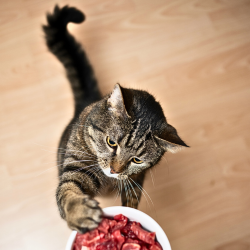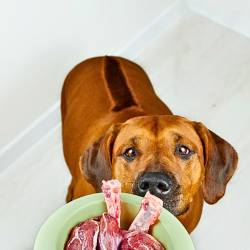Thinking about boosting your pet’s bowl with raw, or switching to 100% raw? There are many more reasons to feed raw, but we stopped at our top ten (plus one bonus reason). If you can feed entirely raw, the results will be dramatic and undeniable. But even a small amount of raw, whether it’s in the bowl or a treat, boosts nutrition and opens the door to the major health improvements as outlined below.
Clean Teeth & Breath
Kibble needs starch in its ingredients for those little nuggets to stick together, and starch is food for plaque. Plaque is the sticky film made from bacteria, food particles and saliva that forms over teeth and hardens into tartar and forms bad breath. Raw meat contains live enzymes, beneficial bacteria and a pH that makes it harder for plaque and tartar to form. Add recreational or edible raw bones to the diet for adding scraping and your animals will have clean, white teeth and healthy gums. For information about incorporating raw bones and healthy chews to the diet, read more here.
Healthy Ears & Paws
The starch in kibble also feeds yeast. When yeast in the body grows out of control, it often shows up in itchy, red and smelly ears and paws. Raw food starves yeast and keeps overgrowth in check with beneficial bacteria that produces compounds that inhibit yeast growth, builds a robust gut biome that helps the immune system defend against all manner of disease, and even creates a beneficial bacterial barrier on skin that helps protect against infection.
Shiny, Lustrous Coat
When you change from a conventional dry pet food to a raw diet, the improvement in the coat is one of the first things you’ll notice. Dry, dull coats change quickly to soft, silky and shiny. Balanced raw diets are very dense with nutrients. And because raw diets are so highly digestible, these nutrients are available to nourish the entire body and particularly the skin and coat. Balanced raw diets are rich in omega-3 and omega-6 essential fatty acids, which work together to maintain moisture balance, reduce inflammation, and promote that soft, shiny coat.
Lean Body Weight
Starch spikes blood sugar, and unless your dog or cat is highly active, the body stores the excess sugar as fat. Over time that can lead to obesity and diabetes. Balanced raw diets have no starch or fillers, just dense protein, fat, complex carbohydrates and water content that’s present in the whole raw ingredients. All of which are absorbed by the body and utilized rather than stored as fat. Animals on a raw diet maintain a stable body weight and lean muscle mass.
Say Goodby to Bad Smells
Conventional pet diets are made with additives and fillers that result in unhealthy balance of yeast and bad bacteria that create more dander, gas, stool, eye goo and ear wax. These excretions are the result of the body trying to get rid of what it can’t absorb and use. Raw diets are highly digestible, and the body uses and absorbs almost all of it. The good bacteria present in raw foods keeps yeast and bad bacteria in check. Cats and dogs on a raw diet have noticeably bright eyes, shiny coat and clean breath and ears. Sorry, but all poop smells! However, stools will be compact and easy to pick up with minimal bad odors.
Long Life
Over time, a conventional commercial dry diet stresses the immune, digestive, urinary and adrenal systems. The filtering organs have to work overtime to supply the hydration needed, the pancreas has to direct its energy to create the enzymes needed to break down food, the gut becomes overpopulated with bad bacteria, yeast overgrowth leads to infection and leaky gut, and the immune system won’t have the resources it needs to fight disease. All of that extra work taxes the body, depletes its resources and results in a shorter life span. Raw diets contain within them the enzymes needed for digestion, and also good bacteria, pH, hydration, amino acids, essential fatty acids and nutrients that support rather than stress the body. Pets on a balanced and complete raw diet live longer, healthier lives.
Stools that are Small, Firm and Easy to Pick Up
Cat and dogs on a raw diet have stools that are smaller, firmer and have less odor. Sometimes the poop is pale, or even chalky white in color, which is normal and attributed to increased calcium. Nearly all of what they are eating when on raw is absorbed and utilized, so there’s less to clean up, and there’s less bad bacteria to create odor.
Robust Digestion
Complete and balanced raw diets contain all the nutrients needed for optimum health, and they also contain the enzymes needed to break down and absorb the food. That means less gas and cleaner pick ups, but also increased absorption of nutrients, and a more robust gut biome, which translates to a healthier digestive system and also a healthier immune system.
Vitality
As your pet drops weight and gains muscle mass due to the dense nutrition, high protein content and absence of starches and fillers, you’ll notice an increase in energy. The essential fatty acids and naturally occurring collagen in a complete raw diet also supports cartilage and joints, which eases discomfort and increases mobility.
Hydration and Kidney support
Raw diets contain whole meats, vegetables and fruits, all of which have a high water content. The water in raw food is released gradually as the food is metabolized – and this is the ideal way to get hydration because it’s a slow drip on a cellular level. Cats especially benefit from this kind of hydration since they are not natural water drinkers. Cats simply can’t drink the volume of water needed to metabolize a commercial dry diet, and that puts a lot of stress on their kidneys. Kidney disease is the number one killer in cats, and it can be prevented by supporting kidney function with proper hydration.
Bonus reason
They will love it. Ideally start them off as puppies and kittens, and they will take to it naturally. If you are transitioning to raw from a conventional diet, take the time to do it gradually. Plan for at least two weeks of gradually increasing the amount of raw and decreasing the old food. Dogs generally embrace raw food immediately, but if you have a picky eater, start with freeze-dried and add bone broth or goat’s milk to ensure it’s re-hydrated and irresistible, and then slowly transition to defrosted frozen raw. Cats, as ‘imprint eaters’ (they imprint the texture and aroma of the food they were brought to eat as a kitten), often take a longer time transitioning to any new diet, so don’t be disappointed if it takes a couple of months to switch. Start with a very small amount of freeze-dried raw rehydrated with bone broth or goat’s milk, and gradually increase. Stay with freeze-dried, or switch to frozen raw when fully transitioned. And when they do, don’t be surprised if you see a ‘where has this food been all my life’ expression behind those whiskers!
Note: These are opinions based on 23 years of experience researching, buying and selling raw food diets in our stores. Our interest as a company is only in offering our experience for the benefit of animals, with the deep-rooted desire to improve the quality of life, health, happiness and life span of cats and dogs. If you have any concerns about feeding a raw diet, we invite you to research it independently. If your vet is open to discussing nutrition, then talk to your vet. Goat’s milk is not available for purchase in MA and some other states.

